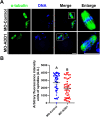Phosphorylation of adducin-1 by TPX2 promotes interpolar microtubule homeostasis and precise chromosome segregation in mouse oocytes
- PMID: 36539904
- PMCID: PMC9769001
- DOI: 10.1186/s13578-022-00943-y
Phosphorylation of adducin-1 by TPX2 promotes interpolar microtubule homeostasis and precise chromosome segregation in mouse oocytes
Abstract
Background: ADD1 (adducin-1) and TPX2 (targeting protein for Xklp2) are centrosomal proteins and regulate mitotic spindle assembly. Mammalian oocytes that segregate homologous chromosomes in Meiosis I and sister chromatids in Meiosis II with a spindle lacking centrosomes are more prone to chromosome segregation errors than in mitosis. However, the regulatory mechanisms of oocyte spindle assembly and the functions of ADD1 and TPX2 in this process remain elusive.
Result: We found that the expression levels and localization of ADD1, S726 phosphorylated ADD1 (p-ADD1), and TPX2 proteins exhibited spindle assembly-dependent dynamic changes during mouse oocyte meiosis. Taxol treatment, which stabilizes the microtubule polymer and protects it from disassembly, made the signals of ADD1, p-ADD1, and TPX2 present in the microtubule organizing centers of small asters and spindles. Knockdown of approximately 60% of ADD1 protein levels destabilized interpolar microtubules in the meiotic spindle, resulting in aberrant chromosome alignment, reduced first polar body extrusion, and increased aneuploidy in metaphase II oocytes, but did not affect K-fiber homeostasis and the expression and localization of TPX2. Strikingly, TPX2 deficiency caused increased protein content of ADD1, but decreased expression and detachment of p-ADD1 from the spindle, thereby arresting mouse oocytes at the metaphase I stage with collapsed spindles.
Conclusion: Phosphorylation of ADD1 at S726 by TPX2 mediates acentriolar spindle assembly and precise chromosome segregation in mouse oocytes.
Keywords: ADD1; Acentriolar spindle assembly; Aneuploidy; Interpolar microtubule stability; Mouse oocyte; TPX2.
© 2022. The Author(s).
Conflict of interest statement
The authors have no relevant financial or non-financial interests to disclose.
Figures








Similar articles
-
Adducin-1 is essential for spindle pole integrity through its interaction with TPX2.EMBO Rep. 2018 Aug;19(8):e45607. doi: 10.15252/embr.201745607. Epub 2018 Jun 19. EMBO Rep. 2018. PMID: 29925526 Free PMC article.
-
NEDD1 is crucial for meiotic spindle stability and accurate chromosome segregation in mammalian oocytes.Dev Biol. 2010 Mar 15;339(2):439-50. doi: 10.1016/j.ydbio.2010.01.009. Epub 2010 Jan 15. Dev Biol. 2010. PMID: 20079731
-
TPX2 deficiency leads to spindle abnormity and meiotic impairment in porcine oocytes.Theriogenology. 2022 Jul 15;187:164-172. doi: 10.1016/j.theriogenology.2022.04.031. Epub 2022 May 8. Theriogenology. 2022. PMID: 35576634
-
Meiotic spindle formation in mammalian oocytes: implications for human infertility.Biol Reprod. 2018 Feb 1;98(2):153-161. doi: 10.1093/biolre/iox145. Biol Reprod. 2018. PMID: 29342242 Review.
-
The chromosomal basis of meiotic acentrosomal spindle assembly and function in oocytes.Chromosoma. 2017 Jun;126(3):351-364. doi: 10.1007/s00412-016-0618-1. Epub 2016 Nov 11. Chromosoma. 2017. PMID: 27837282 Free PMC article. Review.
Cited by
-
Nicotinamide mononucleotide biosynthesis and the F-actin cytoskeleton regulate spindle assembly and oocyte maturation quality in post-ovulatory aged porcine oocytes.Cell Commun Signal. 2025 Apr 17;23(1):186. doi: 10.1186/s12964-025-02200-4. Cell Commun Signal. 2025. PMID: 40247324 Free PMC article.
-
c-Myc Drives inflammation of the maternal-fetal interface, and neonatal lung remodeling induced by intra-amniotic inflammation.Front Cell Dev Biol. 2024 Feb 28;11:1245747. doi: 10.3389/fcell.2023.1245747. eCollection 2023. Front Cell Dev Biol. 2024. PMID: 38481391 Free PMC article.
-
Causal Inference and Annotation of Phosphoproteomics Data in Multiomics Cancer Studies.Mol Cell Proteomics. 2025 Mar;24(3):100905. doi: 10.1016/j.mcpro.2025.100905. Epub 2025 Jan 9. Mol Cell Proteomics. 2025. PMID: 39793886 Free PMC article.
References
Grants and funding
LinkOut - more resources
Full Text Sources
Miscellaneous

